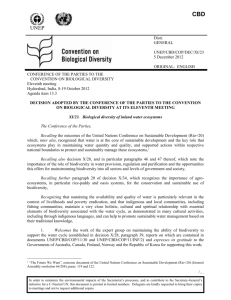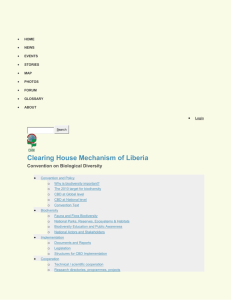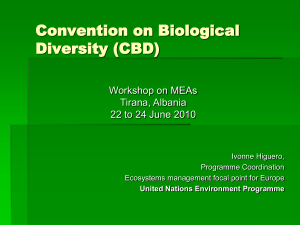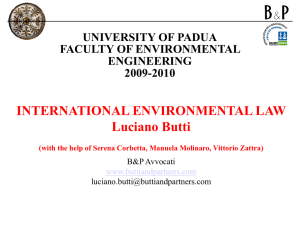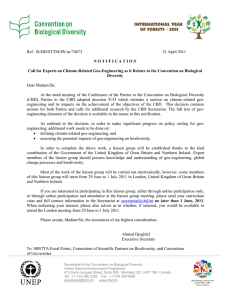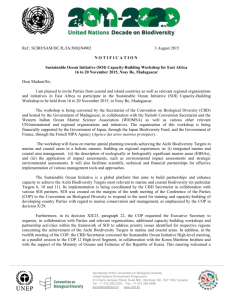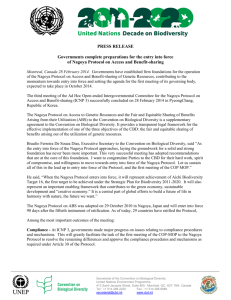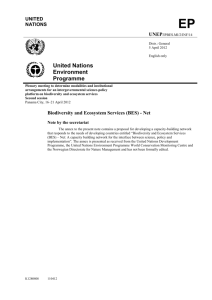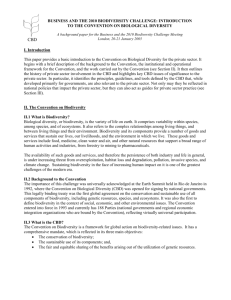“bio-bridge” an initiative of the republic of korea in support of the
advertisement
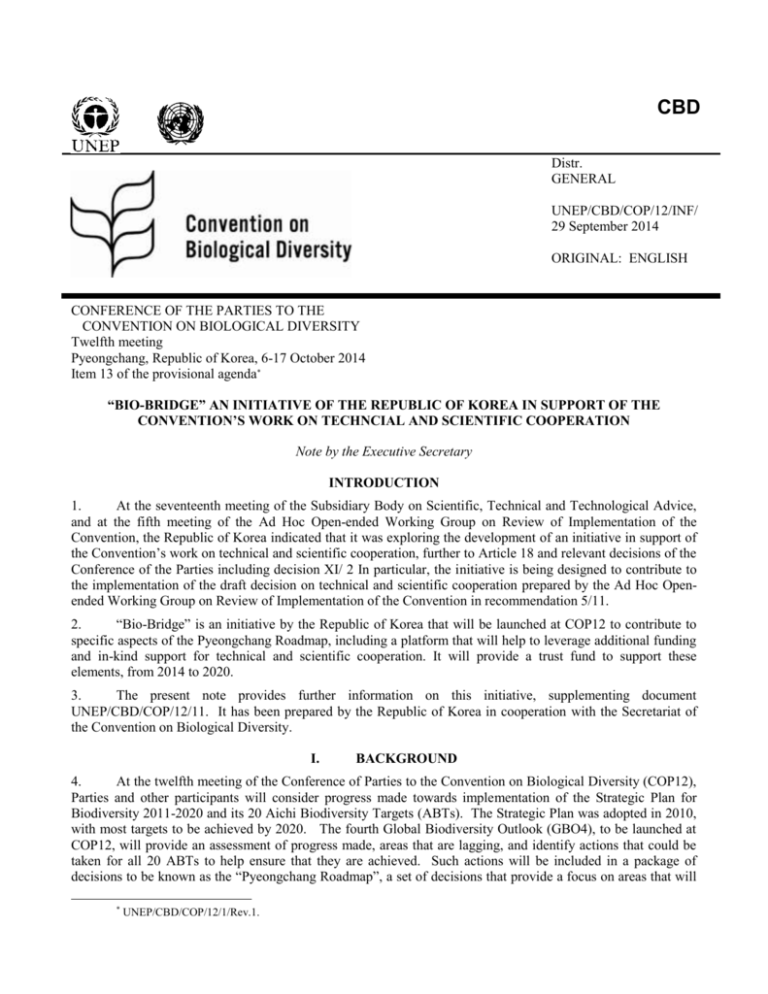
CBD Distr. GENERAL UNEP/CBD/COP/12/INF/ 29 September 2014 ORIGINAL: ENGLISH CONFERENCE OF THE PARTIES TO THE CONVENTION ON BIOLOGICAL DIVERSITY Twelfth meeting Pyeongchang, Republic of Korea, 6-17 October 2014 Item 13 of the provisional agenda* “BIO-BRIDGE” AN INITIATIVE OF THE REPUBLIC OF KOREA IN SUPPORT OF THE CONVENTION’S WORK ON TECHNCIAL AND SCIENTIFIC COOPERATION Note by the Executive Secretary INTRODUCTION 1. At the seventeenth meeting of the Subsidiary Body on Scientific, Technical and Technological Advice, and at the fifth meeting of the Ad Hoc Open-ended Working Group on Review of Implementation of the Convention, the Republic of Korea indicated that it was exploring the development of an initiative in support of the Convention’s work on technical and scientific cooperation, further to Article 18 and relevant decisions of the Conference of the Parties including decision XI/ 2 In particular, the initiative is being designed to contribute to the implementation of the draft decision on technical and scientific cooperation prepared by the Ad Hoc Openended Working Group on Review of Implementation of the Convention in recommendation 5/11. 2. “Bio-Bridge” is an initiative by the Republic of Korea that will be launched at COP12 to contribute to specific aspects of the Pyeongchang Roadmap, including a platform that will help to leverage additional funding and in-kind support for technical and scientific cooperation. It will provide a trust fund to support these elements, from 2014 to 2020. 3. The present note provides further information on this initiative, supplementing document UNEP/CBD/COP/12/11. It has been prepared by the Republic of Korea in cooperation with the Secretariat of the Convention on Biological Diversity. I. BACKGROUND 4. At the twelfth meeting of the Conference of Parties to the Convention on Biological Diversity (COP12), Parties and other participants will consider progress made towards implementation of the Strategic Plan for Biodiversity 2011-2020 and its 20 Aichi Biodiversity Targets (ABTs). The Strategic Plan was adopted in 2010, with most targets to be achieved by 2020. The fourth Global Biodiversity Outlook (GBO4), to be launched at COP12, will provide an assessment of progress made, areas that are lagging, and identify actions that could be taken for all 20 ABTs to help ensure that they are achieved. Such actions will be included in a package of decisions to be known as the “Pyeongchang Roadmap”, a set of decisions that provide a focus on areas that will * UNEP/CBD/COP/12/1/Rev.1. UNEP/CBD/COP/12/xxx Page 2 help support implementation of the ABTs. Other key decisions to be included in the Road Map are decisions related to integration of biodiversity into poverty eradication and development, resource mobilization, and technical and scientific cooperation. 5. Article 18 of the Convention on Biological Diversity provides that Parties shall promote international technical and scientific cooperation in the field of conservation and sustainable use of biological diversity, where necessary, through the appropriate international and national institutions. Article 18 further states that special attention should be given to the development and strengthening of national capabilities, by means of human resources development and institution building (Article 18.2). It also calls on Parties to establish a clearinghouse mechanism to promote and facilitate technical and scientific cooperation (Article 18.3), promote cooperation in the training of personnel and exchange of experts (Article 18.4), and promote the establishment of joint research programmes and joint ventures for the development of technologies relevant to the objectives of the Convention (Article 18.5). 6. At the eleventh meeting of the Conference of the Parties (COP 11), the COP requested the CBD Secretariat to identify coherent and integrated approaches for enhanced support and promotion of technical and scientific cooperation, and to engage in a process towards establishing a capacity-building network of national and regional centres to support the implementation of the Strategic Plan for Biodiversity 2011–2020 and the achievement of the Aichi Biodiversity Targets in developing countries. 7. The Secretariat provided a report to the Ad Hoc Working Group on Review of Implementation of the Convention, at its fifth meeting on implementation of this decision. The Working Group recommended the Conference of the Parties, at its 12th meeting, to adopt a decision calling on “the Executive Secretary, in collaboration with partners, taking into account and avoiding duplication with other efforts, such as those of the Intergovernmental Science-Policy Platform on Biodiversity and Ecosystem Services, and subject to the availability of resources, to enhance technical and scientific cooperation and technology transfer under the Convention, with a view to supporting the effective implementation of the Strategic Plan for Biodiversity 20112020 and its Aichi Biodiversity Targets, as well as revised and updated national biodiversity strategies and action plans.” The recommendation laid out the key elements of such an initiative II. THE BIO-BRIDGE INITIATIVE 8. At present, although there is a great deal of technical knowledge, information, and willingness for institutions and organizations to help Parties meet their international obligations under the CBD, Article 18 remains under-realized. This proposal, called Bio-Bridge, seeks to address some of the identified structural deficiencies that will enable more systematic and sustainable technical and scientific cooperation. Bio-Bridge recognizes the comparative advantages and relative strengths of institutions to deliver support to Parties. It will facilitate the linking of needs with support through effective partnerships of national, regional and global organisations and institutions. 9. The Bio-Bridge initiative will focus on several aspects of the Pyeongchang Road Map. First, it will provide core support to the Secretariat to develop the platform envisioned in the Technical and Scientific Cooperation proposal referred to in paragraph 7 above. The platform will create a more effective means to facilitate matchmaking of Party needs with support for implementation. The platform will capture and articulate Party needs as well as good practices in a user-friendly manner, utilizing the new Clearinghouse Mechanism of the Secretariat. Regional and global trends and groupings of areas of need with respect to all 20 Aichi Biodiversity Targets will be identified, which will facilitate provision of support for the priority needs as identified by Parties. 10. Bio-Bridge will assist efforts by the Secretariat to develop a network of entities with expertise in biodiversity and ecosystems who can partner in organizing and delivering technical and scientific cooperation and support. Finally, Bio-Bridge funding will also be used to support specific regional activities, based on the priorities identified, to provide technical and scientific cooperation. 11. More specifically, the proposed elements to be undertaken under the Bio-Bridge Initiative include: UNEP/CBD/COP/12/xxx Page 3 (a) Facilitating the communication of technical and scientific needs and priorities of Parties, utilizing the clearing-house mechanism and other appropriate means by: (i) Identification and communication of user needs (ii) Development of enhanced functionality for the clearing house mechanism (iii) Publication of newsletters/outreach materials (b) Further enhancing the availability and accessibility of information with respect to best practices and expertise for technical and scientific cooperation to make it more readily and effectively available through the clearing-house mechanism and other appropriate means by: (i) Making existing information more readily accessible and available (ii) Development of additional materials for enhanced technical and scientific cooperation (c) Facilitating the linking of the needs of Parties with support for technical and scientific cooperation by relevant global, regional and national organizations and initiatives by: (i) Convening capacity building workshops to assist CBD Parties in the articulation of requests; (ii) Organizing and convening workshops, training and roundtables, to link needs with support; and (iii) New architecture for monitoring and facilitating the linking of needs with support (d) Implementation: (i) Development of more effective partnership arrangements to enhance implementation. (ii) Catalysing regional and/or thematic pilot activities 12. The Initiative will be developed in cooperation with related initiatives under the Convention and IPBES including: (a) The proposed IPBES Matchmaking Facility that is being developed in the context of the IPBES Capacity Building Forum, (b) The wider IPBES BES-Net web platform. The aim of the BES-Net portal is to facilitate access to the work of IPBES network participants who are developing capacity in the interface between science, policy and practice. (c) The NBSAP Forum is developing a mechanism whereby Parties express their interest in obtaining technical support for the revision and update of their NBSAPs1. 13. (d) The proposed peer-review mechanism under the Convention (e) Thematic initiatives under the Convention. Bio-bridge is envisaged to be a six-year initiative. ______ 1 http://nbsapforum.net/#read-thread/738
